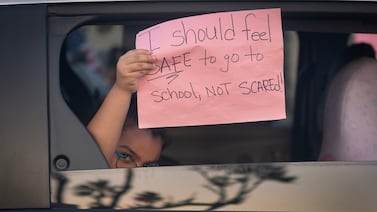Sign up for Chalkbeat Indiana’s free daily newsletter to keep up with Indianapolis Public Schools, Marion County’s township districts, and statewide education news.
A proposed redesign of Indiana’s high school graduation requirements to emphasize student choice and work-based learning has drawn concerns from educators who say it’s too much change too soon.
The plan would offer Indiana students beginning with the class of 2029 two diploma options, one of which resembles today’s graduation requirements but with less advanced math and social studies, and another that would require significantly more work experience.
Indiana education officials presented their plan to significantly redesign diplomas to the State Board of Education in March, touting the new emphasis on career training in high school as a first-in-the-nation move.
But some educators say the proposed requirements leave out key academic courses like world history and language in favor of more work experience, which they say may not be the best track for all students.
Preparing graduates to enter the workforce immediately after high school has been a priority for Indiana, especially as college-going rates stagnate. In addition to proposing new diplomas, the state recently rolled out Career Scholarship Accounts that give students some state funding for workforce training in high school, as well as career-focused graduation tracks that often allow students to start work while in school.
The state’s current Core 40 diploma requires students to take a set of foundational classes throughout grades 9-12 in English, math, science, social studies, and other courses. Students can also earn an honors designation for academics or technical skills.
Beginning with the Class of 2023, all students also have to undertake some college or career preparation.
At a State Board of Education meeting this month, many educators said it’s too soon to change the requirements again.
“If there’s any broad advice, it’s please slow down,” said John Hurley, a Career and Technical Education teacher at the South Spencer School Corporation. “While portions of the new diplomas are labeled flex, smaller schools will likely not be able to offer all options, and students will become stuck in only one track for graduation.”
What’s new about Indiana’s proposed diplomas?
Indiana is proposing two diploma tracks.
One is the GPS Diploma, which is a combination of the current Core 40 diploma and the graduation pathways — the additional college or career preparation requirements added starting with the class of 2023.
The other is the GPS Diploma Plus, which requires more work experience and more evidence of college readiness.
Students will make graduation plans in middle school to determine which courses they’ll take throughout high school.
Both diplomas begin with foundational requirements worth a total of 20 points in grades 9 and 10. These require students to demonstrate:
- Academic mastery of English, math, and science by taking four credits of each subject.
- Civic, financial, and digital literacy by taking U.S. history, government, personal finance, and computer science, as well as demonstrating skills in one of the above by participating in a robotics team, starting a student-led business, or working as a poll worker.
- Work ethic by taking P.E., health, and other activities during or after school. Students must also meet three of six other criteria, such as having a 94% attendance rate, a 3.0 GPA at the end of grade 10, or two seasons of an activity.
- Communication and collaboration by participating in four school activities like debate, Future Farmers of America, or student council, and one outside activity like volunteering or leading a church youth group.
- College and career readiness by taking one readiness course and showing competency in three other ways, for example, taking a career aptitude test or dual credit course, or attending a job fair or a job shadowing opportunity.
Beginning in grade 11, students pursuing the regular GPS Diploma would need to earn 20 more points — similar to the Core 40 requirements — but would be able to choose which courses they take to do so.
Meanwhile, those earning a GPS Diploma Plus will take additional courses they need to complete a work-based learning opportunity and earn a credential.
The GPS Plus diploma has three levels. First is the Level 2 Plus diploma where the student must complete 75 hours of work-based learning. A level 3 diploma requires 650 hours of a state pre-apprenticeship, or modern youth apprenticeship. And a level 4 diploma requires 2,000 hours in a U.S. Department of Labor Registered Apprenticeship.
Diploma Plus students must also demonstrate postsecondary readiness by earning a professional credential, an International Baccalaureate diploma, or an AP Scholar with Distinction designation.
Some new requirements are controversial
Some educators say the heightened emphasis on work experience comes at the expense of academics and could hurt students aiming to attend out-of-state universities.
But not everyone agrees that the work experience requirements are too much.
At a March State Board of Education meeting announcing the new diplomas, Secretary of Education Katie Jenner said the lowest tier of work experience required by the GPS Diploma Plus could be completed in one semester with an internship taken during one period. Some people had pushed for that bar to be higher, she said.
At a marathon public comment session during the May board meeting, teachers said the regular GPS Diploma was not rigorous enough for their brightest students, who would feel compelled to meet the work experience required by the GPS Plus Diploma perhaps at the expense of academic courses.
“What we are missing is a huge middle,” said Aaron Warner, a teacher in Terre Haute. “To get that bottom diploma, your maximum math class is Algebra I. No world history required. That is not the direction we need to be going.”
A junior at Borden Junior-Senior High School, told the board that the choice of the two diplomas requires high school freshmen to make a choice that’s difficult to reverse.
“Between those two options, I would feel far too intimidated by the strenuous workload of the higher level courses and would end up restricting myself to the GPS diploma, which in turn would inhibit my chance of changing my mind once I get into my later years of high school,” the student said.
Educators also told the board that classes like world history and languages are missing from the requirements.
Finally, they took issue with the state changing graduation requirements yet again when the graduation pathways have only been in effect for one graduating class so far.
Hurley, the South Spencer schools teacher, also questioned how students’ hours outside school would be tracked, and how the new requirements would affect students who transfer to Indiana schools late in high school.
What are the next steps?
The department will host two public comment periods this year, as well as accept feedback through its online form, prior to a final adoption of the requirements this fall.
Schools can opt-in to begin offering the new diplomas as soon as the requirements are adopted by the state board of education. They’ll go into effect for all students beginning with the Class of 2029, or today’s seventh graders.
The state will continue to offer the federally mandated alternative diploma for students with severe disabilities.
Aleksandra Appleton covers Indiana education policy and writes about K-12 schools across the state. Contact her at aappleton@chalkbeat.org.






